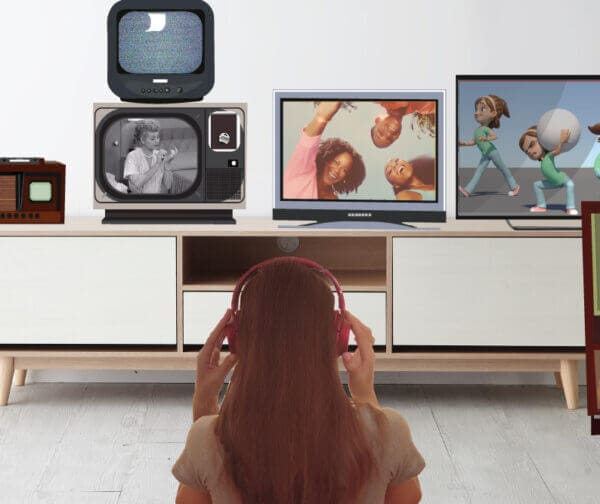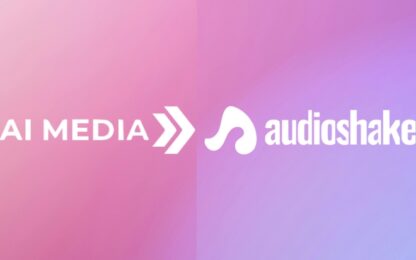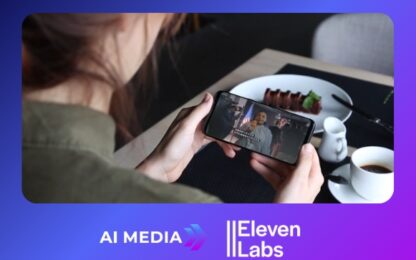
A History of Audio Description
TV programs and movies are inherently visual mediums, and as such, for many years, people who were blind or had low vision could not fully enjoy the experience, even though television was part of their lives.
The Social Life of Blind People: a Leisure Activities Study in 1961, found that people who were blind or had low vision watched television despite common ‘frustrations’, and in 1977, a study lead by Martin Berkowitz concluded that people who are blind or have low vision watched TV “nearly as much as sighted people.”
The Very First Audio Description Services
WGBH-TV in Boston developed the first integrated audio description-type service in 1990 – Descriptive Video Services (DVS®). It provided narration for the key visual elements in TV programs and movies, without interfering with audio dialogue.
Before WGBH-TV created DVS, there had been other attempts at enriching the TV experience for blind people and those with low vision. In the 1960s, some used audio cassettes alongside Star Trek programs, and in the 1970s, a radio broadcaster described movies over a Philadelphia radio station. In 1981, Dr. Margaret Pfanstiehl described live theater performances in Washington, DC.
Dr. Pfanstiehl went on to found the Metropolitan Washington Ear, and she and her husband Cody are often credited with developing the art and technique of audio description. They trained many describers in the art of ‘talking pictorially’ to make theater, television, films, museums and exhibits accessible to people with little or no vision.
How Is It Done?
Creating audio description for a TV show or movie starts with trained, professional writers composing the descriptions for insertion during pauses in the dialogue. It’s a thoughtful, creative, and time-consuming process.
The descriptions are then professionally recorded in a studio where the describer uses uniquely designed computer software to map out the pauses in a program and to craft the most expressive and effective description possible.
When WGBH originally created their audio description service, they used a third audio channel – known as a Separate Audio Program (SAP) channel – to broadcast the narrated descriptions.
Today, there are several options. For over-the-air broadcasters, Ai-Media delivers a timed audio track with the audio description, and it is delivered via an additional channel.
With the advent of streaming content, online content delivery services such as Netflix allow customers to select the audio description track, much in the same way they can opt to turn closed captions or subtitles on.
Audio descriptions can be read by a human or use synthetic voices generated from a computer, which have come a long way.
Popular Culture Trials Audio Description
In 1986, WGBH conducted the first broadcast test of DVS – five episodes of the Mystery! TV series in the Boston area.
With a successful initial trial, both in terms of technical success as well as being well-received by test audiences, WGBH went on to create a national test and develop a business and operational plan for the ongoing operations of their audio description services.
The national test consisted of an entire season – 39 episodes of American Playhouse, which 10 SAP-equipped Public Broadcast Stations (PBS) aired across the US.
Catching On
In the summer of 1988, DVS was introduced at the American Council of the Blind, to an enthusiastic reception. And in 1990, WGBH hired a full-time staff to support and run the DVS service for as additional PBS programs that were enhanced with the DVS service.
Dan Glisson, who developed the software used in the US for captioning, was hired to design the software and work stations needed to free describers’ time for the creative aspects of describing. His new software addressed the tedious and logistical issues, such as marking the scenes that need to be described and identifying the pauses in the program’s audio.
Audio description is also called ‘Described Video’, ‘Video Description’, ‘Descriptive Narration’, ‘Visual Description’. They are all, in essence, the service of describing what’s happening on the screen in between the dialogue of a TV show or movie.
Visit Ai-Media’s website to learn all about our accessibility services covering captioning, translation and transcription.


